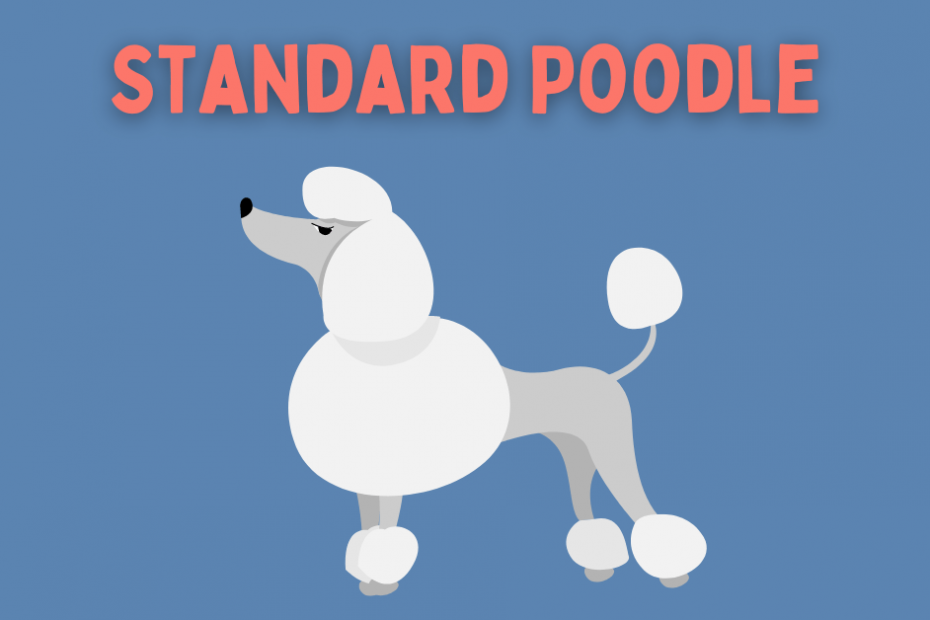When you think of a Poodle you think of a fancy lap dog or maybe even a fashion accessory. Let’s be honest Poodles get a bad rap.
Poodles, like most dog breeds, were bred for a practical purpose. They were bred as water dogs to help retrieve game from the icy cold waters of Europe.
A deeper dive into the history of Poodles gives us better insight as to what we should really expect from this curly-haired dog breed.
In this guide, I provide everything you need to know about the wonderful Poodle dog breed.
What Is The Breed History Of Poodles?
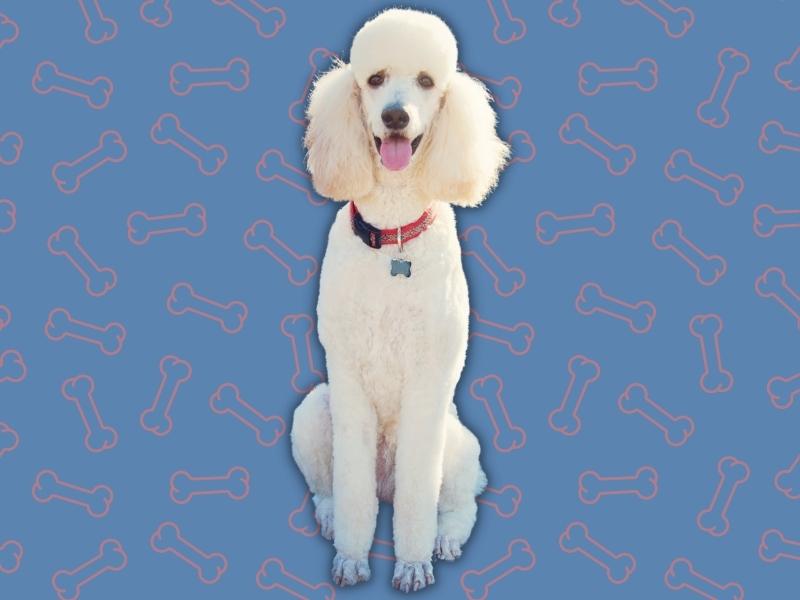
Poodles were bred during the early fourteenth century in Germany. This surprises many people as the dog has long been associated with France. There is some argument from the French as they claim. Poodles originated from the French Barbet dog. Most kennel clubs acknowledge Poodle origins as being in Germany.
Poodles were taken to France by noblemen, where they became wildly popular. Poodles are the French national dog and are often called the French Poodle. In France, Poodles are called Caniche, which means “duck dog.” The name Poodle arose from the German word “pudel,” which means splashing.
Poodles were bred as hunting dogs with the specific purpose of retrieving waterfowl. They were bred with dense coats to help them withstand the icy cold rivers and lakes.
The hunters soon found that the dense coat created problems for the dogs in the water. The sheer weight of the thick coat slowed the dogs down when swimming and caused them to tire quickly.
To remedy this, they shaved the dogs over the back end, leaving the hair longer over critical areas to keep those body parts warm.
This cut is traditionally known as a continental clip and was considered a practical necessity when using Poodles for hunting. As a water retriever, it allowed for Poodles to be comfortable retrieving game in cold water. It also protected their vital organs.
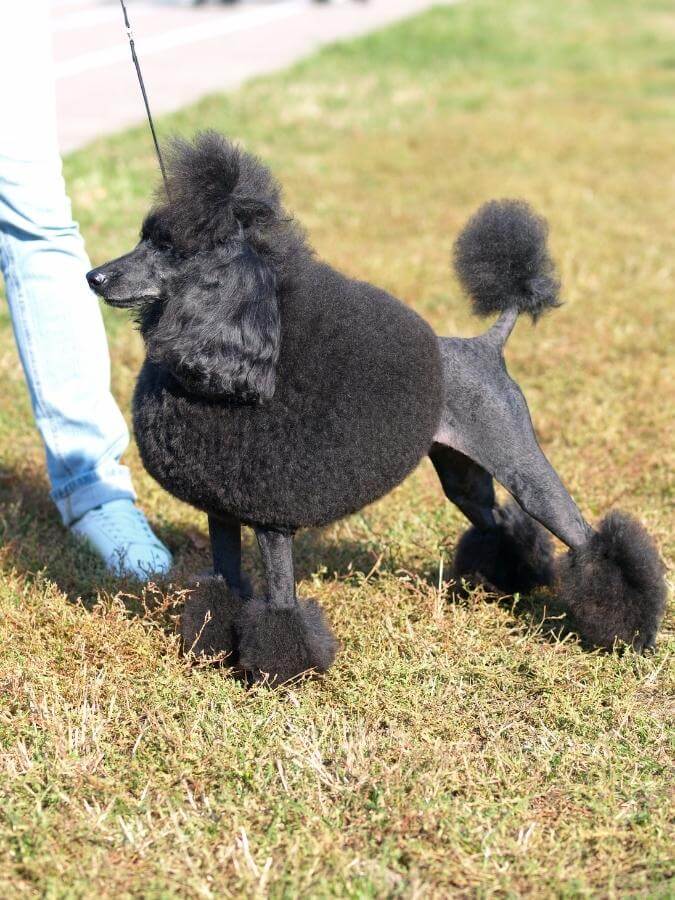
Poodles were also used in Europe for truffle hunting. Poodles are excellent scent dogs and were able to smell and find the truffles easily.
As waterfowl hunting declined in popularity, Poodles became popular as circus dogs. Their intelligence allowed them to quickly learn tricks which delighted the crowds.
Modern Popularity
From 1960 to 1982, Poodles were the number 1 most popular dog breed in the United States. To this day, they still uphold the record of having the longest reign of any other breed with an impressive 22 years.
Since then, Poodles have remained on the top ten list of the most popular breeds globally, and history gives us a sense that they will stay there for generations to come.
When Were Miniature Poodles First Bred?
Poodles were so popular that the French nobility began selecting some smaller specimens as pets. They bred these smaller Poodles to each other, and miniatures came into existence in the seventeenth and eighteenth centuries.
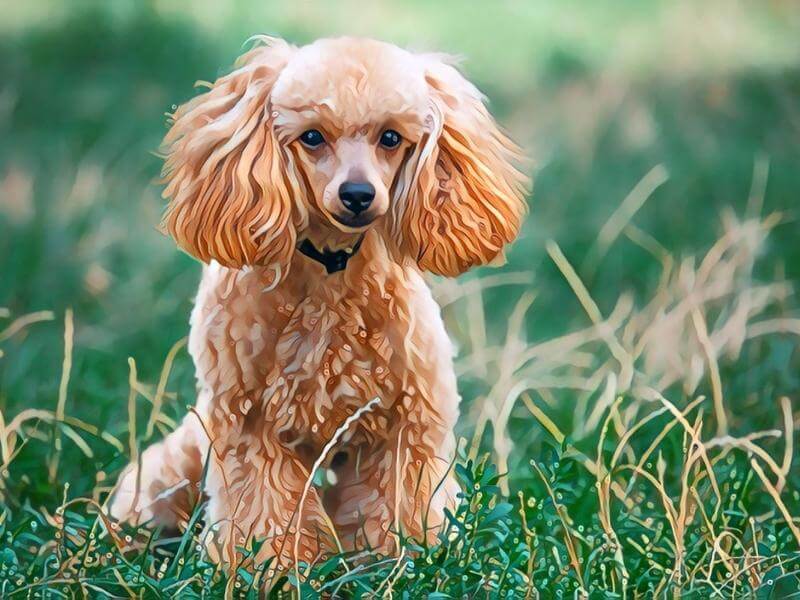
What Is the Breed History Of Toy Poodles?
At the same time, miniature Poodles were bred, and even smaller Poodles became popular in France. These Poodles were the start of Toy Poodles. In this era, the dogs were known as ‘sleeve dogs.’ They were small enough for owners to carry around in their arms.
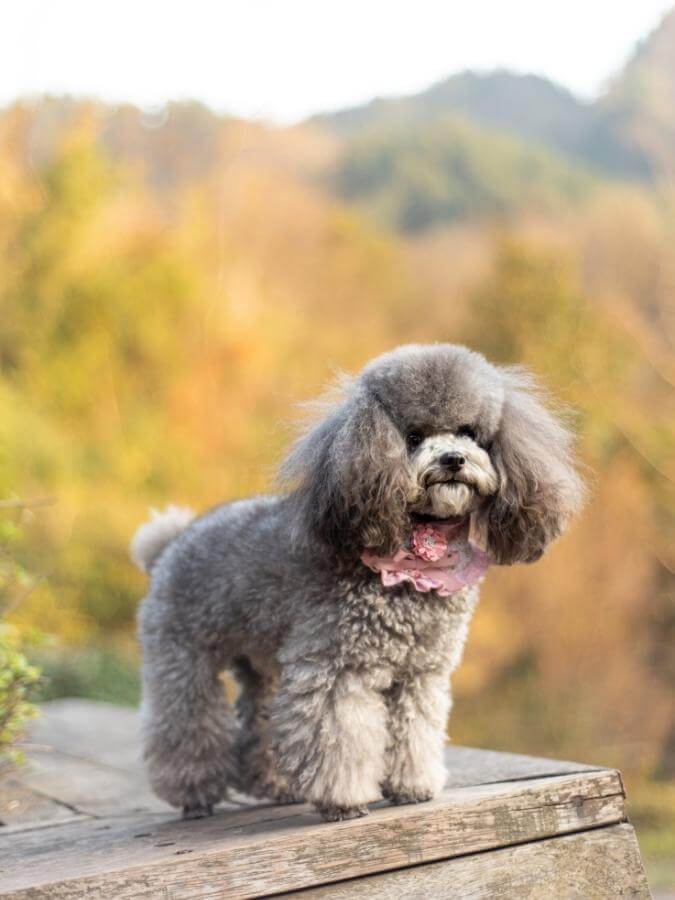
Toy Poodles were often elaborately groomed, with the fashion being to make the dog look as much like the owner as possible. Their coats were cut, puffed, and dyed to make them fashion accessories.
How Did Teacup Poodles Develop?
Over the decades, some people have begun breeding Poodles that are even smaller than Toy Poodles. They are tiny dogs and can easily fit into a handbag. The American Kennel Club does not acknowledge Teacup Poodles.
What Size are Poodles?
The table below shows all the sizes (height and weight) from 3 months to adulthood for each of the three different sizes of Poodle.
| Type Of Poodle | Age | Height | Weight |
| Standard Poodle | 3 months | 13″ to 19″ | 10 to 22 lbs |
| 6 months | 19″ to 23″ | 23 to 45 lbs | |
| 1 year | 24″ to 27″ | 34 to 65 lbs | |
| Adult | 24″ to 27″ | 38 to 70 lbs | |
| Miniature Poodle | 3 months | 5″ to 8″ | 3 to 4 lbs |
| 6 months | 8″ to 13″ | 6 to 9 lbs | |
| 1 year | 10″ to 15″ | 9 to 18 lbs | |
| Adult | 10″ to 15″ | 10 to 20 lbs | |
| Toy Poodle | 3 months | Up to 8″ | 2 to 6 lbs |
| 6 months | Up to 9″ | 4 to 8 lbs | |
| 1 year | Up to 10″ | 4 to 11 lbs | |
| Adult | Up to 10″ | 4 to 12 lbs |
Standard Poodles are the biggest and stand over 15 inches (38 cm) at the shoulder. The males weigh 60 to 70 pounds (27 to 32 kg), and the females weigh 40 to 50 pounds (18 to 23 kg).
Miniature Poodles are medium size dogs. They are 10 to 15 inches (25 to 38 cm) and weigh 10 to 15 pounds (4.5 to 7 kg).
Toy Poodles are the smallest AKC-recognized Poodle size. They are not more than 10 inches (25 cm) and weigh 4 to 6 pounds (1.8 to 3 kg).
Teacup Poodles are under 9 inches (22 cm) and weigh 3 to 5 pounds (1.2 to 2.5 kg) or less. The AKC does not recognize this size, and dogs of this size cannot participate in AKC shows.
Appearance
Poodles are sturdy dogs with a thick curly coat. Their body length is the same as the distance from their wither (shoulder) to the ground, giving them a square body shape.
Poodles have dark, oval eyes with intelligent, alert expressions. Their ears are set at eye level or just below and hang close to the head. They have thick feathering on their ears.
Their muzzles are long and slender, with a clearly defined chin and flat cheeks. The skull is rounded and leads onto a robust and elegant neck that allows the Poodle to hold its head up with an air of dignity.
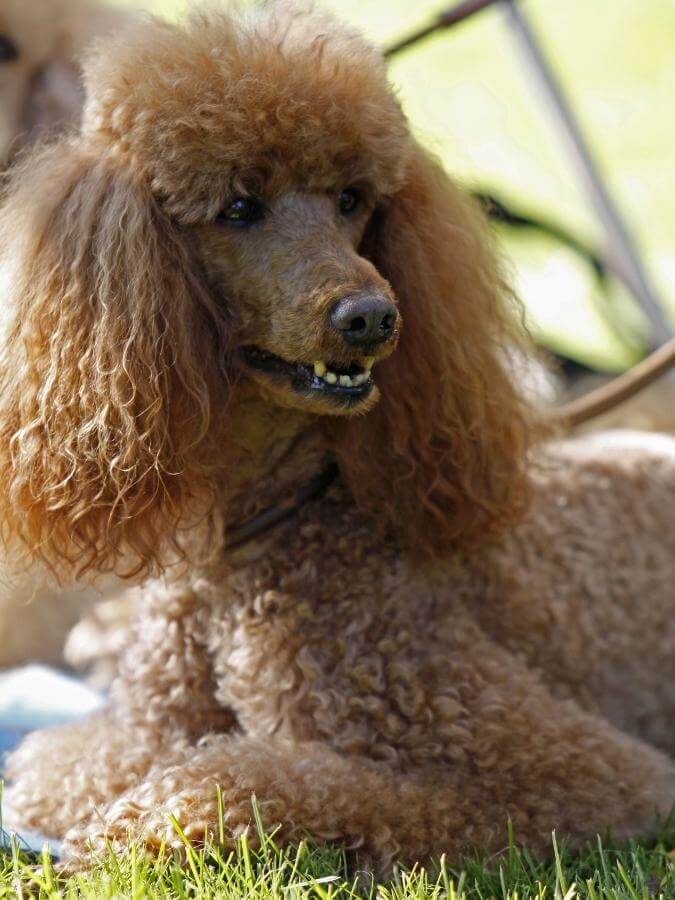
Poodles should have a level topline with a deep chest. Their tails are straight and set high and carried upward. Poodle’s tails are often docked, and some kennel clubs still require a docked tail.
Tail docking is becoming increasingly frowned upon and has been illegal in Europe since 1998. Many countries are following this trend and making tail docking illegal.
Some Poodles have curled tails, but this is considered a significant fault in the show ring and is penalized as a fault. It does, however, not affect the dog’s health in any way, and a Poodle with a curled tail can function just as well as one with a straight tail.
Poodles have neat oval feet with webbed toes that assist them when swimming.
What Type Of Coat Do Poodles Have?
Poodles have dense coats that may be curly or corded. The coat is waterproof, helping to keep the dog warm when swimming in icy water.
Poodle puppies have soft, wispy coats that are initially straight. As the puppy ages, the coat becomes dense and curly. The puppy coat may be present until the puppy is up to a year old.
The adult Poodle coat is comprised of coarser hair. Curly coats are the most common in Poodles, but some Poodles have corded coats with dreadlocks as thick as a pencil.
A Poodle should have curls over the entire body to score well in the show ring. Some Poodles have what is termed an ‘improper’ coat. They have curls in some areas, but the coat has waves rather than curls in other body regions. Once again, this does not affect the dog’s temperament or health and is purely related to showing correctness.
Poodles’ hair continues growing, and any hair shed is retained in the curls. This can cause matting if the coat is not cared for adequately.
Different Poodle Clips
A puppy clip is acceptable for dogs under one year in the show ring. It is a common clip for pet Poodles as it is easy to maintain and keeps the dogs cool.
The Poodle’s hair is cut to an equal length over the entire body except for the base of the tail, face, throat, and shaved paws.
As with other clips, a puppy clip is also practical for pets as it prevents Poodles from getting burned by the sun. The hair is long enough to protect the dog’s skin from thorns that scratch and sand or dirt that can irritate.
In an English saddle clip, the Poodle’s face, throat, forelegs, feet, and the base of the tail are shaved. The hair over the front leg joints is shaped into a rounded ball and is commonly known as a pompon. The hair on the back legs is cut into a series of pompons.
The hair over the Poodle’s hindquarters is cut to a short blanket. There are additional shaved areas on each flank and a band on each hindleg. A pompon is left at the end of the tail.
The third style of cut is the continental cut, which originated when Poodles retrieved downed game while hunting waterfowl.
The hindquarters are shaved. The chest hair is left as a mane to keep the heart and lungs warm, and pompons are left over the kidney area. The pompons over the kidney area are optional in the show ring.
The coat over the leg joints is left unshaven and is known as bracelets on the hind legs and pompons on the front legs.
A rounded tuft of hair is left at the tip of the tail. The original purpose was to help hunters locate the dogs while swimming. A dog’s tail is also prone to injury if the hair is shaved off the tip, as it is easily traumatized during wagging.
The sporting cut is similar to a puppy cut, but the body hair is cut to only one inch in length. There is a pompon on the tail, and the hair on the top of the head is shaped into a cap.
Are Poodles Hypoallergenic?
There are no fully hypoallergenic dogs as all dogs have the primary dog allergen, Canis familiaris (Can f1). This protein is found in dogs’ hair, dander, and saliva. The difference is that dogs that do not molt elicit fewer allergic reactions in some allergy sufferers.
Poodles do not molt, and as a result, they are often labeled as hypoallergenic. It is best for someone with an actual dog allergy to have laboratory tests or do a field test where they expose themselves to a Poodle before adding one to their family.
Purchasing a Poodle only to discover that you are allergic to it is a disservice to you and the dog.
Allergen immunotherapy injections can help those with severe dog allergies that wish to own a Poodle. Hardwood or tile flooring in the house instead of carpets reduces the amount of allergen that accumulates. Frequent vacuuming and air filters can keep allergen levels in check.
What Are A Poodle’s Coat Colors?
Poodles come in many colors. Solid color Poodles show consistent coloring at the base of the hair throughout the body. The colors may be:
- Apricot
- Cream
- Black (may turn grey at four to five year)
- Grey
- Blue
- Brown
- Café au lait
- Red
- Silver
- Silver Beige
- White
Particolored Poodles have an inconsistently coloring at the base of their coat. This color pattern is considered a fault in the show ring but does not affect the Poodle’s health.
Coat Patterns
Poodles have a few different coat patterns. Below are some examples of Poodle coat patterns:
- Merle*
- Blue Merle
- Red Merle
- Liver Merle
- Parti-color (50% white base color with a different secondary color)
- Phantom (mixture of two colors in which the base color is not white)
- Tuxedo (white patch on chest)
- Brindle (black and tan stripes)
- Monocolor
- Tricolor
*Merle is not in the Poodle genes. However, the merle pattern in Poodles is a debated topic. Technically, a merle Poodle will be the result of an impure bloodline.
An honorable mention is the abstract Poodle. Abstract is a coat pattern in which less than 50% of the coat is white. Abstract can also be called a Mismark Poodle.
Traits & Characteristics

The Poodle Personality
Poodles are loving, loyal dogs that bond closely with their owners. They do best when they can be with their owners for most of the day. Poodles are generally content with any family member, although some bond strongly to only one person.
Standard Poodles are usually child-friendly, but miniature and Toy Poodles may need to be socialized with children early.
Children must be taught to be considerate and gentle with the smaller Poodles, as boisterous children may unintentionally hurt the dogs. Teacup Poodles are generally not good dogs for children. They are too small and easily intimidated and hurt by children.
Standard and miniature Poodles may be friendly or aloof with strangers, depending on their confidence levels and individual personalities. They generally have some reserve and may take time to warm up to new people. They are unlikely to be aggressive to strangers.
Toy or teacup Poodles must be exposed to new people, often as puppies, to avoid them becoming anxious when strangers visit. They are prone to possessiveness and fear aggression if not correctly bred and socialized.
Poodles of all different sizes are usually social with other dogs and animal species. Toy and teacup Poodles may be intimidated by bigger dogs, but this can be corrected with training.
Poodles are brilliant dogs, rated second after Border Collies on many dog intelligence charts. Their intelligence and amenability make them good dogs for first-time dog owners.
The intelligence and sensitivity of Poodles have made them popular as service dogs and therapy dogs. Even untrained Poodles are sensitive to their owner’s moods and reflect this by becoming extra attentive or playful depending on the owner’s emotions.
Poodles are often described as clowns. Their intelligence leads them to explore everything, and their responses are amusing and entertaining. Poodles have big personalities, and potential owners must be aware that these dogs will make an impact when they join the family.
Poodles’ incredible traits and characteristics have made them a popular choice for mixed, or designer breeds. Poodle mixes, better known as Doodles, have become wildly popular throughout the world.
General Care Of Poodles
Poodles are not dogs that can be left outside in the backyard. They want to be part of the family and will do best when they can sleep indoors and be present with a family member most of the day. Poodles with shaved haircuts will be too cold outdoors in winter and may be burned by the sun in summer.
Poodle puppies use their intelligence to explore their surroundings and may get themselves into trouble by doing this. To keep your Poodle puppy safe, it is critical to puppy-proof your home and garden.
Vaccinations are essential in ensuring the safety of your Poodle. Poodle puppies need vaccinations to achieve immunity, followed by booster shots. It is vital to ensure that puppy vaccinations are given at the correct intervals to protect the Poodle from fatal diseases such as parvovirus and distemper.
How Much Exercise Does My Poodle Need?
Standard Poodles are athletic dogs that need quite a bit of exercise. They should have at least one long daily walk of one hour, followed by a short walk at another time. These canine athletes happily accompany their running or cycling owners, expending excess energy.
Miniature Poodles require approximately one hour of exercise a day. Their short legs cannot usually keep up with a running adult for long periods, but they enjoy hiking or brisk walking.
Toy and Teacup Poodles are smaller dogs that do best with thirty to forty minutes of exercise daily. Their tiny frames are not meant for running with people, but they will enjoy daily walks, playing fetch, or other games.
Should I Train My Poodle?
Poodles are highly intelligent dogs that like to please their owners. They are easy to train, and this is what made them such firm favorites as circus performers.
Like any other dog, Poodles need basic training to have good manners around the home and when meeting new people and animals. Basic obedience training is vital for all Poodles.
Owners of toy and teacup Poodles are often remiss in training their dogs. They feel the dog is so cute and tiny that training is unnecessary.
Unfortunately, these intelligent little dogs are happy to become miniature dictators and develop what is known as small dog syndrome.
The teacup or Toy Poodle becomes the boss in the home, growling and snapping when its demands are unmet. They become possessive and unpredictable. Early training is far easier than correcting a behavioral pattern that has been established for some time.
Poodles are intelligent dogs, and simple physical exercise is unlikely to meet all their needs. It is as important to exercise their brains by providing them with intellectual stimulation in the form of brain games. These can be puzzle toys, scent training, or teaching the dog tricks. Poodles excel at dog sports such as agility, flyball, or advanced obedience.
Poodles thrive on training, and Poodle owners must be prepared to formally or informally train their dogs.
Do Poodles Need Special Diets?
Poodles should eat a high-quality diet that provides all their basic nutritional needs. The owner should choose a commercial kibble suitable for their Poodle’s size as different size dogs have different nutrient needs. Some dog food brands make breed-specific kibble which some Poodle owners prefer.
Recently, there has been a move to feed dogs fresh food. This can take the form of cooked food or raw diets.
Some companies offer owners the option to customize cooked fresh or raw food for their Poodles. The food is delivered weekly or monthly, and the owner is satisfied knowing their dog is getting all their nutrients without working hard.
Dog nutritionists are also helping Poodle owners develop a special diet designed for their dogs. Some owners enjoy cooking or sourcing food for their dogs.
Poodle owners may also prefer to mix food types, feeding some kibble with added home-cooked or raw food.
Healthy Poodles do not need a specialized diet as long as the food is balanced and offers complete nutrition. Omega oils and vitamin E will help keep the Poodle’s dense coat in good condition.
How Often Should I Groom My Poodle?
The grooming needs of pet Poodles depend on how long their coat is allowed to grow. Generally, Poodles should be brushed three to four times a week. If the Poodle has a sport or puppy cut, brushing twice a week should be sufficient.
A Poodle must have its coat cut every six to eight weeks in summer to maintain the desired length. If the Poodle owner wants to allow the coat to grow longer in winter, then the coat can be cut every three months. The longer hair will need more brushing during the winter.
If you aren’t comfortable or skilled at dog grooming, then I recommend taking your Poodle to a professional groomer!
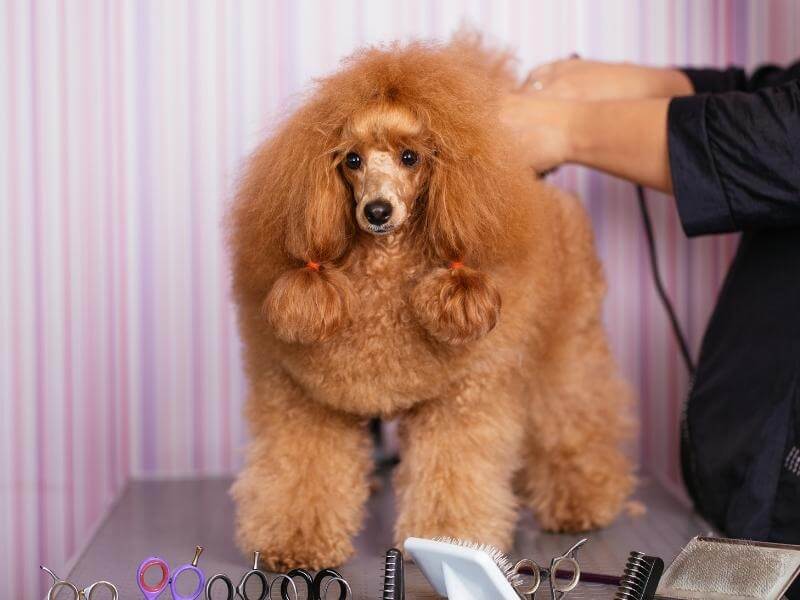
A good slicker brush and bristle brush will provide the necessary tools for grooming a pet Poodle. Maintaining the coats of show Poodles is much more complex, and owners have multiple tools and devices.
People who show their Poodles often spend daily grooming and bushing their dogs. They may trim the coat every two to three weeks to maintain the desired shape and effect.
Do Poodles Have Health Problems?
Unfortunately, almost all modern pedigreed dogs are prone to breed-specific health problems.
Health issues in Poodles include the following;
- Luxating Patella – Associated with limb or joint structure abnormalities such as the area where the dog’s kneecap connects to the shinbone is displaced, or the femur groove at the kneecap is too shallow.
- Epilepsy – Also known as idiopathic epilepsy, is a seizure-causing disease when the dog’s brain is abnormally overactive.
- Skin Tumors (Squamous Cell Carcinoma) – These tumors appear as bumps or raised lumps on the dog’s skin. Though quite rare, breeds at risk include Poodles, Bull Terriers, Dalmatians, and Beagles. It is a very common form of skin cancer in dogs.
- Bladder Stones – These are rock-like formations of minerals that form in a dog’s urinary bladder. The best thing to do if your dog shows symptoms of dysuria and hematuria is to take him to the vet. Bladder stones can be seen through ultrasonic bladder examinations or on radiographs.
- Legg-Calve-Perthes Disease – An orthopedic disorder that causes degeneration of a dog’s (or human) hip joints. Unfortunately, surgery is necessary to treat this disease.
- Hip Dysplasia – The loosening of the dog’s hip joint causing pain and dysfunction. The dog’s rear will start to narrow, and he will have difficulty holding up his back legs. Sadly, this puts tremendous strain on the dog’s spine and front legs.
- Bloat – When a dog’s stomach fills with food, gas, or fluid, causing it to expand, and if the bloating is too severe, it can cause the stomach to twist and rotate.
- Cushing’s Disease (Hyperadrenocorticism) – A condition where the dog’s adrenal glands produce too much of the steroid hormone (cortisol).
- Tracheal Collapse – A progressive respiratory condition that happens when the tracheal rings of the dog’s cartilage collapse.
- Sebaceous Adenitis – A hereditary skin disease that causes color and texture changes in your dog’s coat, as well as hair loss (alopecia).
- Progressive Retinal Atrophy (PRA) – A group of degenerative diseases affecting photoreceptor cells in a dog’s eyes.
- Addison’s Disease – A disease caused by immune-mediated destruction of adrenal tissue.
- Thyroid Problems (Hypothyroid & Hyperthyroid) – A condition where the dog’s body produces either too much thyroid hormone (hyperthyroidism) causing anxiety, diarrhea, hyperactivity, and increased heart rate, or too little thyroid hormone (hypothyroidism) having the exact opposite effect, including lethargy, constipation, etc.
Many of these diseases are inherited and can be prevented by genetic testing and breeding only with healthy dogs that show no evidence of disease.
Hip dysplasia can largely be prevented by x-raying breeding Poodles’ hips. The results are evaluated on a scale, and only dogs with clear hip scores should be bred.
Epilepsy is a complex inheritance and not easy to test for. Breeders who keep records and follow up on their dog’s progeny will quickly identify genetic lines prone to epilepsy. These should be avoided in future breeding.
What Is The Life Expectancy Of Poodles?
Poodles are generally long-lived dogs, with standard Poodles living for 12 to 15 years. Miniature and Toy Poodles may live longer, and 15 to 18 years is not uncommon.
Where To Get A Poodle: Adopt Or Buy
When you have decided that a Poodle is the right dog for you and your family, you have two options. You can adopt a Poodle from a rescue agency or buy a puppy from a breeder. They both have advantages and disadvantages.
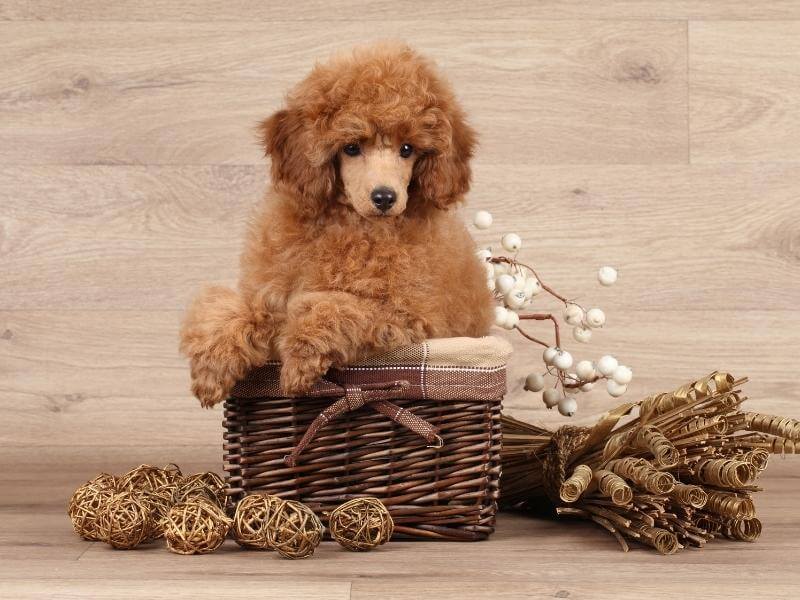
Adopt From A Rescue Group
Sadly Poodles, like any other dog breed, end up in shelters and breed rescue groups. Most adoptions from rescues are adult Poodles. An advantage is that you can assess if the dog has the right temperament for your home with the advice of shelter staff.
Many shelters offer the services of behaviorists that help the dog adapt to its new home and assist the new owners with any issues that arise.
A Poodle adopted from a shelter will already be sterilized, vaccinated, dewormed, and microchipped. It is rare to get the chance to adopt a Poodle puppy from a shelter, although it does sometimes occur.
Unfortunately, there will be minimal information on the breeding and health of the parents if you adopt a puppy through a shelter. You may end up with a Poodle with multiple health problems.
A good source to find Poodle rescues is by checking out the Poodle Club of America. Their website will provide different Poodle rescue information and contact details.
Purchase From A Reputable Breeder
Reputable breeders test their dogs for health issues and breed puppies that are as healthy as possible. They carefully feed and care for the puppies, socializing them and only allowing them to go to new homes after the puppies are eight weeks old. By this time, the puppy should have started their vaccination program and have been dewormed and microchipped.
Buying a puppy from a reputable breeder usually carries a hefty price tag as it costs a considerable amount to test the Poodle’s parents and raise a healthy litter of puppies.
If you buy a Poodle puppy from a reputable breeder, you have the advantage of knowing more about the health and temperament of the parents, assuring you of getting the dog you want.
A reputable breeder will assess the Poodle puppies’ temperaments and assign them to the best homes, matching their temperaments to the home.
There is a trend to shame anyone who buys a puppy from a breeder, but this is unfair and illogical.
Some owners have other pets that might not accept an adult Poodle but will accept a puppy. Many rescued Poodles have a history of abuse, affecting how they interact with other dogs and people. They might be unpredictable, which can be dangerous for young children.
Not all owners are equipped to handle a dog from an abused or neglected background. These Poodles may have complex issues that are not easy to resolve. Inexperienced owners may need a more level playing field when acquiring their Poodle, and a well-bred puppy is best for them.
Final Thoughts
Poodles were bred as water retrievers, and their thick coat helped protect them from the cold. Standard Poodles were selectively bred to produce smaller toy and miniature types.
They are delightful, loving dogs that quickly become the center of a family’s affection. They adapt well to an active lifestyle and will need long walks and frequent exercise. They have high grooming needs and may not be the right dog for everyone.
For many people, Poodles are the ultimate dog breed, and life would be unimaginable without one.
FAQs
Do Poodles bark a lot?
Standard Poodles do not bark or yap unnecessarily, but the smaller Poodles may be prone to barking more. Individual differences and the environment affect the amount of barking. All-size Poodles will bark an alert to something abnormal in the environment.
Are Poodles aggressive?
Poodles are not aggressive dogs. They do not show aggression toward people and usually get on well with other animals. The only exception is toy or teacup Poodles that have not been trained and have become dictators in their homes.
Are Poodles good family dogs?
Standard and miniature Poodles are excellent family dogs, getting on with children and other pets. Toy and Teacup Poodles may need socialization with children and other pets as they are sometimes anxious about being hurt.
Are Poodles smart dogs?
When it comes to intelligent breeds, Poodles are number two in the rankings. The Border Collie is the only breed that is smarter.
Do Standard Poodles like to cuddle?
Standard Poodles love nothing better than lounging on the sofa or bed with their owner. They are affectionate and love cuddles.

